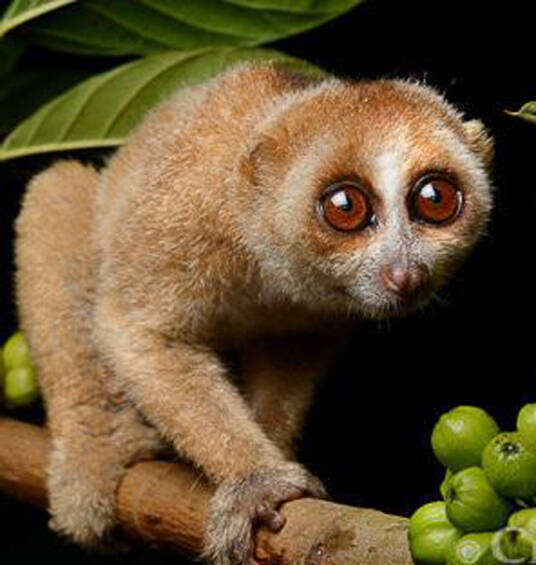Nycticebus kayan
IUCN
LCBasic Information
Scientific classification
- name:Nycticebus kayan
- Scientific Name:Nycticebus kayan,Kayan Slow Loris
- Outline:Primates
- Family:S.loris
Vital signs
- length:About 27.3 cm
- Weight:About 410.5g
- lifetime:7-8年
Feature
Has special "eye bags"
Distribution and Habitat
The Kayan River Slow Slow is found in central and northern Borneo. Its range extends southwards to the Mahakam and Rajang Rivers in East Kalimantan, Indonesia and Sarawak, Malaysia, respectively, and northwards to the southern side of Mount Kinabalu in Sabah, Malaysia. Its range spans Borneo from east to west, although it is not found along the coast. The species' range overlaps with the Philippine Slow Slow in East Kalimantan and Sabah, to which the Kalimantan Slow Slow is a close relative.
It lives in a variety of habitats, native to tropical rainforests in Borneo to severely degraded secondary forests, plantations, lowland and montane forests. Altitude 50-1100 m.
Appearance
The Kayan slow loris is about 273.4 mm long and weighs about 410.5 g. It has a pair of large, forward-facing eyes and large ears. Its face differs from other slow loris in several ways. First, it has special "eye bags", a feature not found in other Bornean slow loris species. The top of the dark circles around its eyes are either rounded or pointed (without spreading edges), and the bottom extends below the zygomatic arch and sometimes even to the chin. Second, the stripe between the eyes is occasionally spherical, compared to the rectangular stripe in neighboring species. In addition, a lighter stripe of fur in front of the ears is usually of medium width compared to other slow loris species. Compared to the Philippine slow loris, the Kayan slow loris has a more dark black and white contrast on its face, and its ears are always covered with fur, while the ear flaps of the Philippine slow loris are usually bare. Its fur is usually longer and fluffier than that of the Philippi
Details
Kayan Slow Loris (Scientific name: Nycticebus kayan) is named after the Kayan River that flows through its territory. It was discovered on the island of Borneo in 2012, when it was classified as a subspecies of the "Philippine Slow Loris" (Nycticebus menagensis), but according to research in museums and physical specimens and photos, the species has unique facial features that classify it as a different species.

The Kayan River slow loris is a social animal, nocturnal, arboreal, and rarely goes to the ground. Its activities, foraging, mating, reproduction, and hibernation are all spent in trees. During the day, it curls up in a ball and hides in the tree holes of tall trees, near the lush canopy of branches and leaves, or on the forks of dense branches to rest. It starts to move around and forage after dusk. They like to move alone and move very slowly, mostly climbing. They do not jump and only speed up when attacked. They forage separately at night and gather in their nests to sleep during the day. Kayan slow loris may also use their venom to catch prey and even protect their young. For example, when a mother slow loris goes out to forage, she will apply venom on her young to stop potential predators. In order to obtain venom, Kayan slow loris rubs glands in its armpits with its hands and then applies venom to its teeth. When it bites prey or predators, it will cause fatal injuries or anaphylactic shock.
Kayan slow loris mainly feed on insects, lizards and eggs, and sometimes eat berries, leaves and flower buds.
Females can mate with males twice a year. The estrus cycle lasts 29-45 days, the gestation period is 166-169 days, each litter has 1-2 pups, and the weaning period is 6-7 months. Females reach sexual maturity at 10 months. The Kayan slow loris has a lifespan of 7-8 years.
The Kayan slow loris is suspected to be declining due to deforestation, forest fires, and the illegal pet trade. The burning and conversion of habitats, especially for palm oil plantations, are almost certainly threats to the species. While it is relatively resilient to anthropogenic habitats, so they may be less affected by forest loss than other primate species, forest loss in the region is very severe and is likely to have had some negative effects. The 2015 forest fires in Borneo were the worst since 2004, with large tracts of forest burned, resulting in a significant reduction in the species' habitat.
Listed in the IUCN Red List of Threatened Species in 2015 ver 3.1 - Near Threatened (NT).
Protect wild animals and eliminate game.
Maintaining ecological balance is everyone's responsibility!








